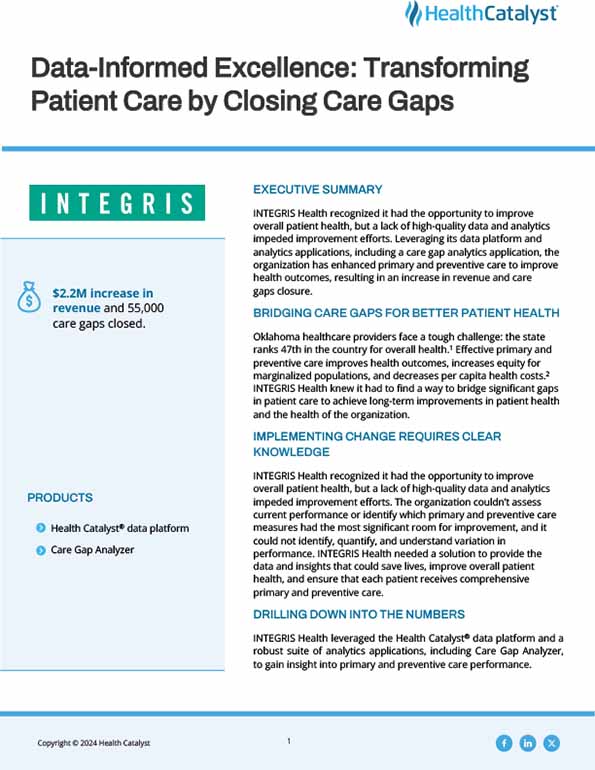INTEGRIS Health recognized it had the opportunity to improve overall patient health, but a lack of high-quality data and analytics impeded improvement efforts. Leveraging its data platform and analytics applications, including a care gap analytics application, the organization has enhanced primary and preventive care to improve health outcomes, resulting in an increase in revenue and care gaps closure.
Oklahoma healthcare providers face a tough challenge: the state ranks 47th in the country for overall health.1 Effective primary and preventive care improves health outcomes, increases equity for marginalized populations, and decreases per capita health costs.2 INTEGRIS Health knew it had to find a way to bridge significant gaps in patient care to achieve long-term improvements in patient health and the health of the organization.
INTEGRIS Health recognized it had the opportunity to improve overall patient health, but a lack of high-quality data and analytics impeded improvement efforts. The organization couldn’t assess current performance or identify which primary and preventive care measures had the most significant room for improvement, and it could not identify, quantify, and understand variation in performance. INTEGRIS Health needed a solution to provide the data and insights that could save lives, improve overall patient health, and ensure that each patient receives comprehensive primary and preventive care.
INTEGRIS Health leveraged the Health Catalyst® data platform and a robust suite of analytics applications, including Care Gap Analyzer, to gain insight into primary and preventive care performance.
Using Care Gap Analyzer, INTEGRIS Health quickly and efficiently assessed performance across primary and preventive care measures, quantifying baseline performance and prioritizing care gap closure for five measures that impacted tens of thousands of patients. The organization established multiyear improvement targets and aligned performance incentives to reward the team for following established procedures.
INTEGRIS Health engaged leaders, physicians, quality teams, and frontline team members in improving processes and redesigning workflows, implementing standard work for each measure. Teams used the analytics application to identify physicians and medical clinics with high performance, enabling the organization to spread best practices rapidly.
The organization created comprehensive care guides for each measure, clearly documenting and communicating improvement targets, such as how to decrease unintended variation and close each care gap. The care guides include the requirements for each measure, required documentation, tips and tools for increasing patient engagement, common chart deficiencies resulting in failed measures, and exclusion criteria.
Physicians and care teams perform pre-visit planning, identifying the care gaps that need to be closed during each visit. Teams build trusting relationships with the patients they serve, providing patient education and following up with patients to ensure care gaps are closed.
INTEGRIS Health uses high-quality data and analytics in Care Gap Analyzer to evaluate workflow changes’ impact on outcomes and monitor performance. Leaders and teams can quickly drill into the data to identify organization, clinic, and individual physician performance and can easily access detailed data to determine the root causes of low performance, enabling the organization to implement interventions to improve performance more quickly.
INTEGRIS Health broadly shares non-blind performance data and uses patient stories to illustrate improved performance impact on patient lives. Physician-led quality committees routinely review data, recognizing and learning from top performers and providing peer-to-peer education to increase the number of care gaps closed. Data are publicly displayed in each clinic. INTEGRIS Health uses public data to teach patients about the primary and preventive care they should receive and how that care can impact overall health.
INTEGRIS Health’s data-informed improvement efforts have substantially improved performance, leading to better patient care and outcomes. The organization achieved a:
INTEGRIS Health has positively impacted the long-term health of tens of thousands of patients and their families. For example, in just six months, one physician following the standard care gap closure work identified two patients with early-stage breast cancer and two patients with early-stage colon cancer who would not have otherwise been identified. Closing care gaps enabled early detection and treatment, prevented cancer progression, and provided these patients and their families more years of good health and time together.
“The Health Catalyst data platform provides us with the high-value data and analytics needed for ongoing performance improvement. We can see our measures improve each month, demonstrating the power of data transparency.”
- Todd Clapp, MD, Primary Care Physician, INTEGRIS Health
INTEGRIS Health plans to continually expand performance improvement activities to increase the number of patients receiving primary and preventive care. The organization plans to integrate more social determinants of health data into its analytics applications.


